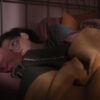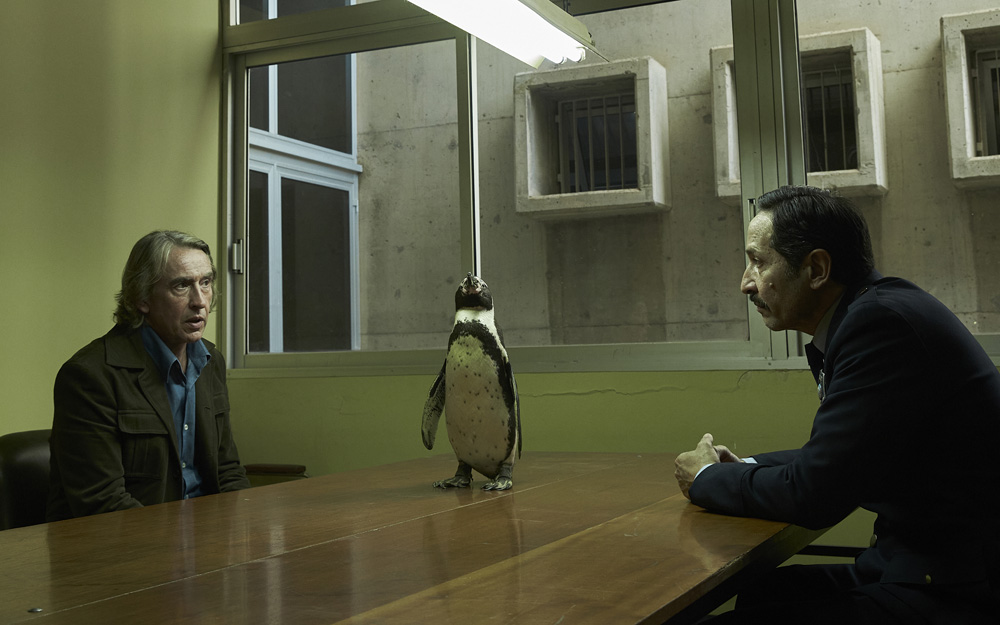There was a word bandied about early on in the process for “The Penguin Lessons” that was verboten as soon as the production got on its feet properly. As much as Steve Coogan trusted Jeff Pope, the screenwriter with whom he had partnered on such films as “Philomena,” “Stan and Ollie” and “The Last King,” there was a danger in adapting Tom Michell’s memoir from his years spent in Argentina as an English teacher during the 1970s when the element that made it irresistible as a potential movie also made it a tonal tightrope when Coogan’s potential co-star would be the tuxedo-wearing bird. “Cutesy” became a grave concern when the tale of a beached penguin, found covered in oil, that begins to open up the heart of its reluctant new owner could easily become too adorable for its own good, particularly if a few too many animal hijinks are leaned on for laughs.
Pope clearly understood the assignment, finding a bittersweet and unexpectedly poignant current underscoring Michell’s increasing willingness to put himself on the line by speaking up more about the fraught political situation in Argentina as it was under a military dictatorship as he learns to care for the penguin, but credit also goes to Peter Cattaneo, a director whose delicate touch can often be overlooked when it’s so light in the first place. Ever since breaking out with “The Full Monty” where it felt like an audience was being stripped of preconceptions of its working class heroes as they were shedding their trousers to make ends meet, the filmmaker has long taken potentially wacky premises and brought out the humanity in them. He does especially thoughtful work in “The Penguin Lessons” where the inherent heaviness of the film’s historical setting never feels too burdensome to connect with Tom as he retreats to South America after feeling useless elsewhere and ends up finding a soulmate, not in Carina (Micaela Breque), the woman he meets at a club and take back to his hotel room, but in Juan Salvador, the penguin she insists on picking up along the way when she sees it struggling for its life.
While Tom has to hide his new feathered friend from authorities ranging from Argentinian police to the headmaster of his school (Jonathan Pryce), it reveals a tenderness that was thought to be lost long ago and as others look to him as an an authority at school, from his class of boys on the cusp of adulthood to people on its staff such as Maria (Vivian El Jaber) and her granddaughter Sofia (Alfonsina Carrocio) who are nervous in uncertain times, not much more needs to be articulated about how he grows into the role to an audience than what he is able to verbally share with the penguin. With incredible command over the frame and a plentiful supply of grace, Catteneo is able to tug at heartstrings without ever feeling as if he’s pulling them and after “The Penguin Lessons” won over audiences at the Toronto Film Festival last fall, the film is rolling out into theaters across the country this week. Catteneo generously spoke about the slippery business of working with penguins, finding his proper fit in collaboration with longtime co-conspirators Pope and Coogan and moderating tone to elicit bigger emotions.
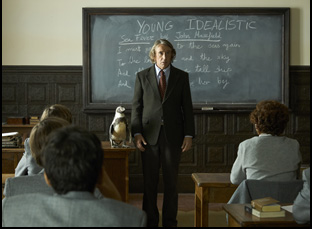
When I first read the book and heard the story of “The Penguin Lessons,” it just felt like such an unexpected juxtaposition of different elements. It was a unique, original story and such a fascinating time in history, from Argentina in the ’70s to this very British private school, to this character and his friendship with a penguin. It felt like a really exciting challenge to mesh all those things together and make a film that I think people can’t kind of say, “Oh, I’ve seen that movie before.” It felt like a really original concept, which could only have come from true life.
Because Steve Coogan and Jeff Pope have such a longstanding relationship, what was it like coming into that situation?
I love Jeff’s work, and I read the script and thought the story felt really good and that there’s something here. And then I’d already been told Steve was like interested in it, so I was like, “Well, if we get Steve, that was a massive draw for me.” And they’re old friends, so it did take a while to just get into becoming a three rather than just a two the whole time, but some of the script meetings were fabulous because Steve would improvise around the scenes and Jeff’s just there writing down ad libs. Steve’s performance feels quite improvised sometimes — and it is, partly because he did come up with the lines in the moment, but [often they were] in prep and then they’d go into the script because I just kept saying, we got penguins, we got young kids on a restricted schedule. We can’t be doing a loose improv-y type shoot. The penguins arrive at this [specific] time and we’ve got this long with them and Steve just completely understood that. We did all the chatting and improvising really before the shoot that went into the script. And then of course, here and there he’ll change a line or come up with a line on the spur of the moment, which is some of the best stuff in the movie.
Having the penguin become almost like a therapist or confidant for not only Tom, but other characters in the film was quite inspired. Was that in the script from the start?
Yeah, we talked to Tom Michell throughout production. We had to get his blessing to make “The Penguin Lessons,” and Tom Michell is in his twenties, not in his fifties [in his memoir], and he was very on board with that. He was just like, “Be true about the penguin and tell stories about people.” And after we made the movie, he said, “You really grabbed that thing of the penguin being a confidant,” which is true. He said, “I remember once I was in the apartment, the curtains were drawn, and I could hear one of the pupils out there talking to the penguin in Spanish about how he’s met this girl in town and he wants to ask her out. What should he say? Should he ask her out?” And I was like, “Oh my God, we could have put that in. Why didn’t he tell us that that had happened in real life?” [laughs] So that’s us very much based on Tom’s accounts of what happened in the school at the time. The great thing about a penguin is like a good therapist is they don’t talk much. They just listen and they allow you, the people, just to talk and they almost hear themselves and that helps them get to some kind of solution.
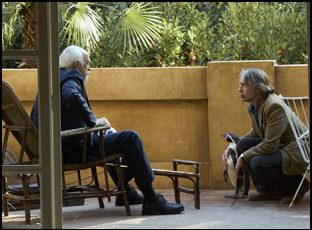
In terms of ’76, that was a big appeal as well. I have done some TV stuff of different periods, but I’ve never done a movie set in the 1970s, and my main thing in terms of the aesthetic was to not go too heavy-handed on it. It’s quite easy to put on ‘70s music, and everyone’s heavily cartoony with the ’70s clothes and hair. You hand over to the heads of department quite a lot and we went and tried to keep it very, very real. And in terms of just the context, it was just about doing a lot of research, spending time in Buenos Aires, talking to Argentinian people, people who’ve lived through the history of that period, and just immersing myself in the true stories of that time.
From what I understand, you actually brought together the Argentinean members of the cast, who may not necessarily have lived through that period themselves, but surely had a sense of it. After having a similar real-life basis on your last film “Military Wives,” is there something you get from that kind of conversation beyond authenticity?
Yeah, I think it helps the actors as well. On “The Penguin Lessons,” I had an Argentinian key cast that we sat down with, and I was interested to hear, “What did you think when you heard about the project? What did you think when you read it? Is there anything you liked, you didn’t like? Things about the history that jarred the Argentinian audience.” That episode in Argentinian history is such an open wound still, it was very, very emotional. They were all in tears and talking about relatives who’ve been disappeared. And it’s very much ongoing in Argentina still at the moment. There’s the new technology of DNA tracking is enabling exhumed bones to be finally reconnected with relatives. And [the scene in the film] when Vivian [El Jaber] put on that scarf when she’s playing one of the initial mothers of Plaza de Majo [the relatives of the disappeared], it was incredibly emotional. So I just wanted to be respectful to their culture. I’m a Brit, and I’ve only been to Argentina for this film, so I just wanted to hear it from the horse’s mouth.
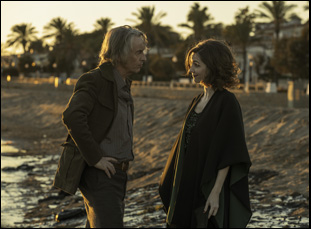
We did a little rehearsal for the bathroom scene and we went up to the penguin accommodation where they were staying. They had a wonderful rented villa with a swimming pool. And we got a bath and we practiced [the scene]. There was a lot to get through with that in terms of being humane with the animals. We had great animal handlers who are very used to it and we also had the American Humane Society who are there all the time observing. You can’t put oil on a penguin, so they came up with this brilliant idea of using squid ink, which is used for cooking, and is completely organic friendly for them.
We also cheated here and there. [The film as a whole] was like 90% real penguin, but in that scene, for example, there’s a puppeteer for the shots and we did it in a couple of takes with actors really improvising. We did the washing the squid ink off the penguin. And then for the reverses, once we knew what the continuity was, we did the reverses as a puppeteer with a puppet penguin was in the foreground. It’s out of focus, so you don’t really look or think about it, but she mimics what the penguin did on the reverses and this wonderful puppeteer was lying in a bath, cut in half in a wetsuit and a mask on because of soap and everything was going all over her face, but she was doing the penguin movements. We had a variety of ways to deal with the things that were unethical to do with the penguin. Same as when it’s covered in oil, we used a robotic model and covered it in an organic matter that looked like oil and it didn’t need to do much apart from just twitch a bit.
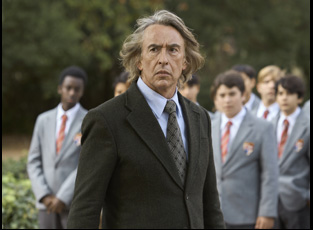
It was more about how to cover the scenes so that you can have a little bit more flexibility in the edits. You’d get the wide shot, and if the penguin did something unexpected, Steve Coogan was very good at staying in character and just going with the flow. If [the penguin] wandered off or it pooped or whatever it did, [we thought] “Let’s make that part of the scene and now we can go in and we can do coverage around that.” Quite often, the penguins were on Steve and he’s acting to a toy penguin out of shot, soI learned efficient ways to not worry about continuity so much was because a continuity person can’t come in and say, “No, last time you waddled slightly over that way. You didn’t waddle on that line.” It was working out ways to have the flexibility in the edit to make the scenes stitch together.
It was beautifully done. You also leave the audience with such a grace note when you have this footage of the real life Juan Salvador at the end, which from what I hear may have helped sell you on making this in the first place. Did you actually have to restore that footage in order to put it in the film?
No, one of the first things I did was just Google it and there it is on YouTube. We couldn’t really restore it much. It was in pretty bad shape, but the fact that it’s weathered and scratched and grainy and got dirt on it adds to the sense of it feeling very authentic. After test screenings, some of the executives were saying “We need to explain that it really is the real penguin that we have in the film.” And I said, “Well, people aren’t going to think we’ve invented this footage,” and it’s amazing the audience reaction that that gets. It’s very similar to our penguin, but people just get even more gooey about the actual Juan Salvador.
“The Penguin Lessons” will open on March 28th in limited release. A full list of theaters is here.


